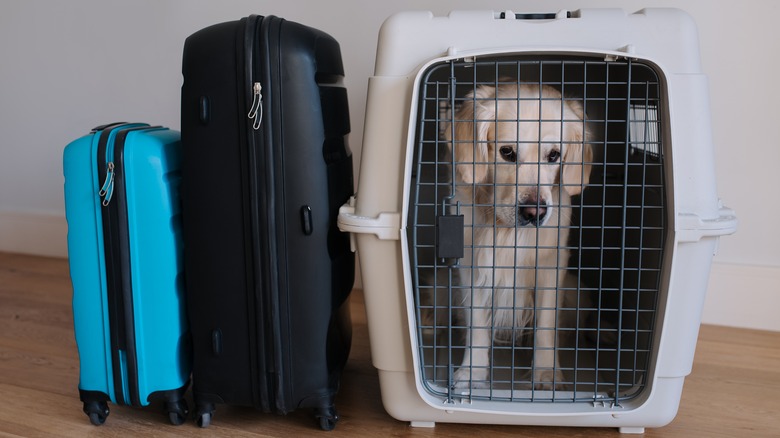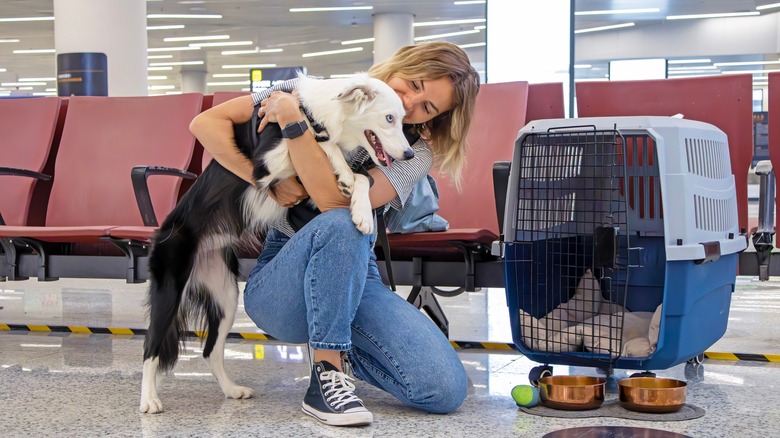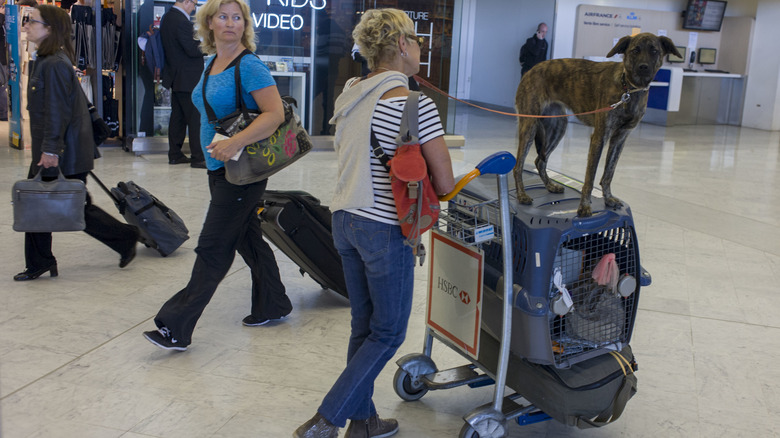How Safe Is It To Put Your Pet In Cargo While Flying?
If you have ever seen your dog flop down on the floor at the sight of your suitcase, knowing that it means you'll be going away, you know how heartbreaking leaving your best friend behind can be. Pets are members of our family, and travel pros with pets have ways of making traveling together a breeze — but if you have to take a plane and your pet would have to ride in cargo, you should probably leave them at home. The vast majority of animals who fly in the hold do arrive at their destination safely. Tragically, though, dogs and cats have died in the cargo hold, leaving devastated families behind.
A lot of cargo holds can get extremely hot or cold during the flight. This can worsen when flight delays leave pets in the plane without power. Most pets can survive the conditions if everything goes according to plan, but if your pet happens to have a health condition that you don't know about, is young or elderly, or is a brachycephalic breed with a pushed-in face like a pug, they may not be able to handle it. Even if they arrive safely, research like a 2002 study from the Canadian Journal of Veterinary Research has shown that the process is highly stressful for dogs. Pet owners must consider which journeys are worth putting their pets through a scary and potentially dangerous process and which are not.
What air travel in the belly of the plane is really like
After you complete your check-in process and say your tearful goodbyes, your pet boards the plane. According to a cargo agent interviewed by Business Insider, the part of the hold where pets are stored is different from the area where your luggage is, so rest assured there aren't going to be suitcases stacked up on your dog's crate. In general, these areas are temperature controlled. However, the air pressure can still fluctuate, it can be dark inside, and it can be extremely loud. As explained by the director of pet care issues for the Humane Society of the United States in an interview with Smithsonian Magazine: "Flying is frightening for animals. They can sense the pressure changing and they can tell that something is happening, and that's scary. Flying is frightening if you don't know what's happening."
Once the plane lands, the ordeal is not necessarily over. Surprisingly, a study from the Canadian Journal of Veterinary Research found that the most frightening part of the journey for dogs may actually be while being loaded and unloaded on and off the plane. In a 2023 study from the academic journal Animals of more than 600 dogs who traveled internationally by plane, almost one-third of owners reported their dog being moderately or extremely distressed when they arrived at their destination. Sadly, some reported that their dog remained unusually stressed days after the flight.
What to do if your pet has to ride in the cargo hold
In a perfect world, you never have to put your pet into the belly of the plane, but sometimes it's unavoidable. There are airlines specifically trying to make flying friendlier for pets and their owners, but these can be outside the budget for a lot of travelers. If you're relocating overseas, sometimes the only affordable option for keeping your pet with you is to put them into the cargo hold for the journey. Remember: the vast majority of healthy pets arrive safe and sound and swiftly reunited with their families at their destination.
In addition to reviewing TSA guidelines for traveling with your pet, there are a few things you can do to make the trip as safe as possible. Before you take your dog on a flight, make sure to visit a vet. Not only is this a requirement for many airlines, but they can help determine if your pet is healthy enough to make the trip and provide tips to reduce your pet's anxiety. You should also do everything possible to book direct flights, as transfers can be dangerous for pets. Just like your luggage can get lost in transit, pets can end up on the wrong flight, too.


